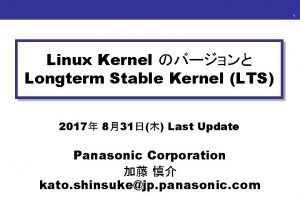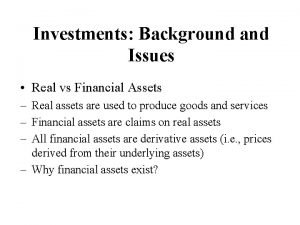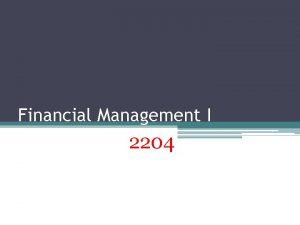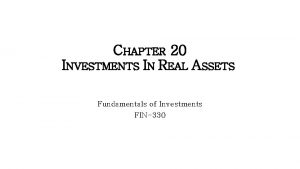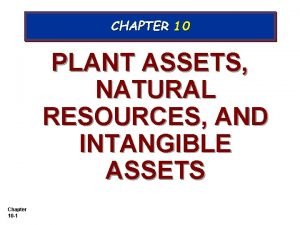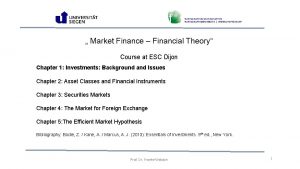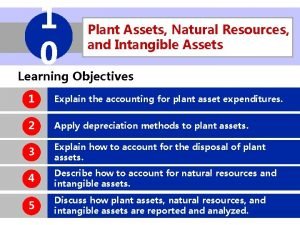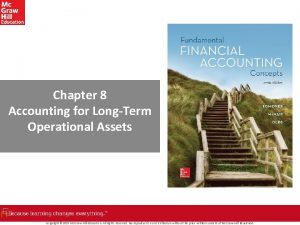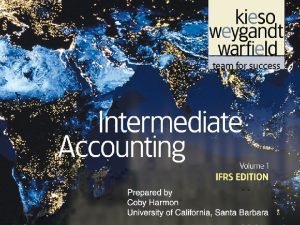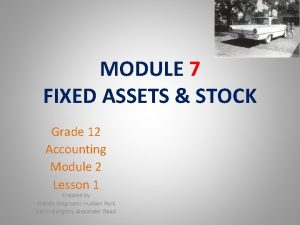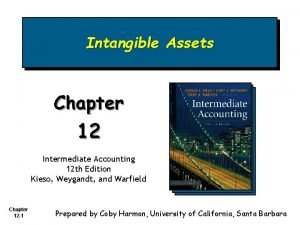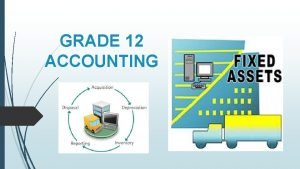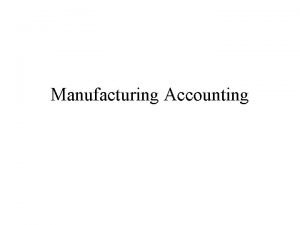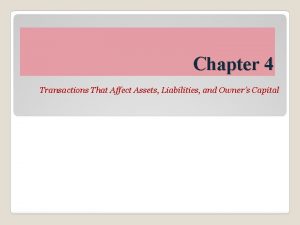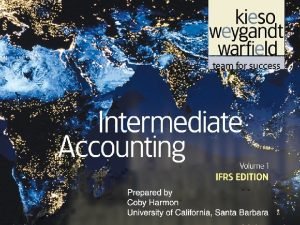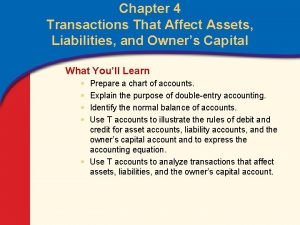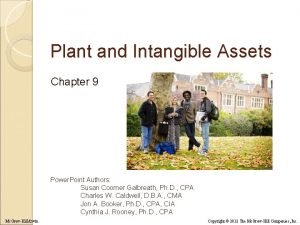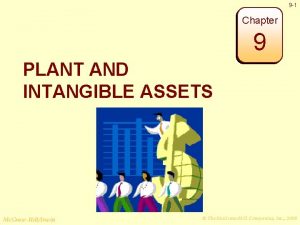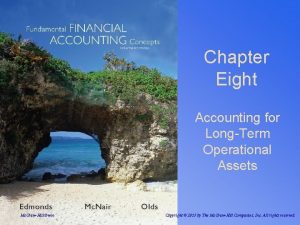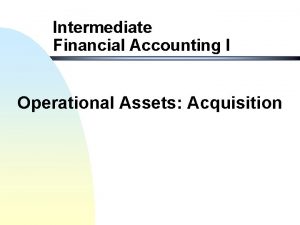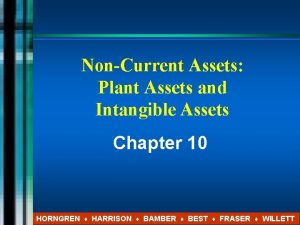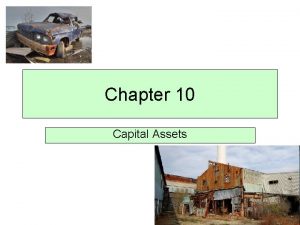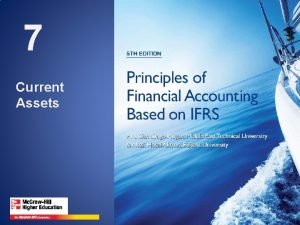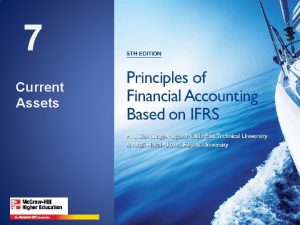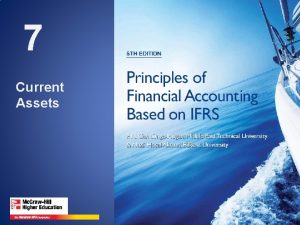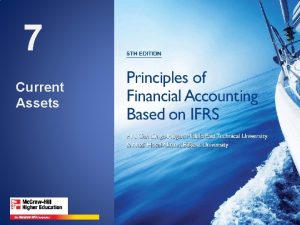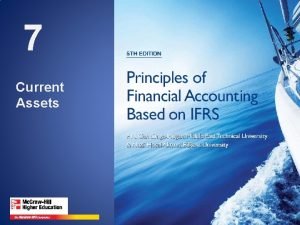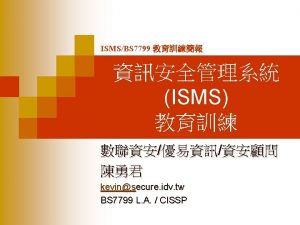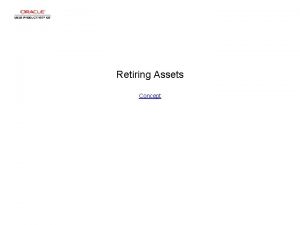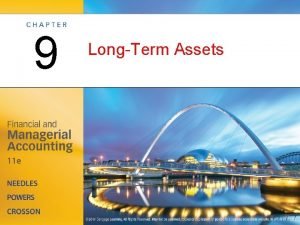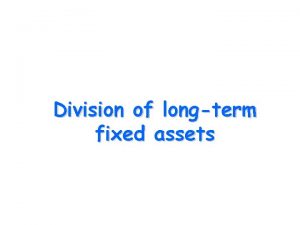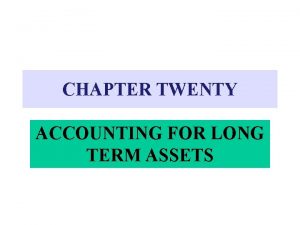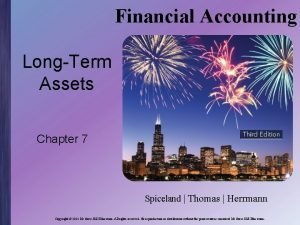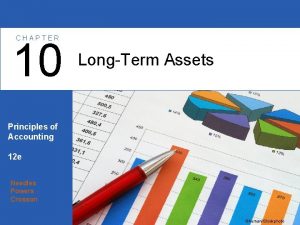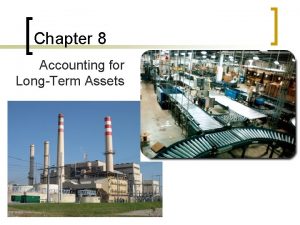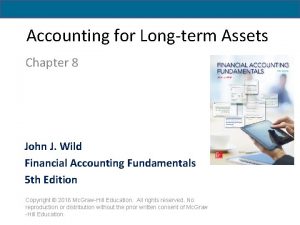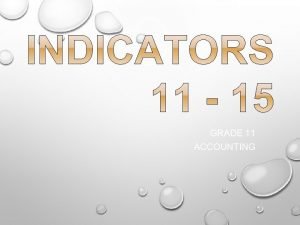Chapter 8 Accounting for LongTerm Operational Assets Copyright





























































- Slides: 61

Chapter 8 Accounting for Long-Term Operational Assets Copyright © 2019 Mc. Graw-Hill Education. All rights reserved. No reproduction or distribution without the prior written consent of Mc. Graw-Hill Education.

LO 8 -1: Identify and determine the cost of long-term operational assets. 8 -1 Copyright © 2019 Mc. Graw-Hill Education. All rights reserved. No reproduction or distribution without the prior written consent of Mc. Graw-Hill Education.

Tangible versus Intangible Assets • Tangible assets have a physical presence; they can be seen and touched. • Intangible assets are rights or privileges. They cannot be seen or touched. Copyright © 2019 Mc. Graw-Hill Education. All rights reserved. No reproduction or distribution without the prior written consent of Mc. Graw-Hill Education. 8 -2

Tangible Long-Term Assets • Property, Plant, and Equipment: Sometimes called plant Equipment assets or fixed assets. We depreciate these assets over their useful life. • Natural Resources: Mineral deposits, oil and gas Resources reserves, timber stands, coal mines, and stone quarries are some examples of natural resources. We deplete these assets over their useful life. • Land: Has an infinite life and is not subject to Land depreciation. Copyright © 2019 Mc. Graw-Hill Education. All rights reserved. No reproduction or distribution without the prior written consent of Mc. Graw-Hill Education. 8 -3

Intangible Assets • Intangible Assets with Identifiable Useful Lives: patents Lives and copyrights. Amortize the cost of each over its useful life. • Intangible Assets with Indefinite Useful Lives: renewable Lives franchises, trademarks, and goodwill. The cost of these assets is not expensed unless it can be shown that there has been an impairment in value. Copyright © 2019 Mc. Graw-Hill Education. All rights reserved. No reproduction or distribution without the prior written consent of Mc. Graw-Hill Education. 8 -4

Cost of Long-Term Assets Buildings Equipment • Purchase price (less discounts) • Sales taxes • Title search and transfer • Sales taxes document costs • Delivery costs • Realtor’s and attorney’s fees • Remodeling costs • Installation costs • Costs to adapt for intended use Copyright © 2019 Mc. Graw-Hill Education. All rights reserved. No reproduction or distribution without the prior written consent of Mc. Graw-Hill Education. 8 -5

Cost of Long-Term Assets (Continued) Land • Purchase price • Sales taxes • Title search and transfer document costs • Realtor’s and attorney’s fees • Costs of removal of old buildings • Grading costs Copyright © 2019 Mc. Graw-Hill Education. All rights reserved. No reproduction or distribution without the prior written consent of Mc. Graw-Hill Education. 8 -6

Basket Purchase Allocation Beatty Co. purchased land a building for $240, 000 cash. An appraiser estimated that the land has a market value of $90, 000, and the building has a market value of $270, 000. Market Value of Building Amount $270, 000 % 75 Market Value of Land 90, 000 25 $360, 000 100 Total Fair Market Value Assign to Building Cost $240, 000 % 75 Allocation $180, 000 Assign to Land $240, 000 25 60, 000 100 $240, 000 Copyright © 2019 Mc. Graw-Hill Education. All rights reserved. No reproduction or distribution without the prior written consent of Mc. Graw-Hill Education. 8 -7

Exhibit 8. 1: Life Cycle of Operational Assets The life cycle of operational assets has four phases in a continuous loop that are used to account for and define the operational asset throughout its lifetime. These functions, in order, are: 1. Acquiring funding 2. Buying the asset 3. Using the asset 4. Retiring the asset Then, the cycle begins again with acquisition of additional operational assets. Copyright © 2019 Mc. Graw-Hill Education. All rights reserved. No reproduction or distribution without the prior written consent of Mc. Graw-Hill Education. 8 -8

Depreciation Methods 1. Straight-line method: The same amount is depreciated each accounting period. 2. Double-declining-balance: Produces more depreciation expense in the early years of an asset’s life, with a declining amount of expense in later years. 3. Units-of-production: Produces varying amounts of depreciation in different accounting periods depending upon the number of units produced. 8 -9 Copyright © 2019 Mc. Graw-Hill Education. All rights reserved. No reproduction or distribution without the prior written consent of Mc. Graw-Hill Education.

LO 8 -2: Calculate straight-line depreciation and show it affects financial statements. 8 -10 Copyright © 2019 Mc. Graw-Hill Education. All rights reserved. No reproduction or distribution without the prior written consent of Mc. Graw-Hill Education.

Asset to be Depreciated The van has a salvage value of $4, 000 and an estimated useful life of four years. List Price of Van Cash Discount (10%) Transportation Cost of Customization $23, 500 (2, 350) 250 2, 600 Cost of Van $24, 000 Copyright © 2019 Mc. Graw-Hill Education. All rights reserved. No reproduction or distribution without the prior written consent of Mc. Graw-Hill Education. 8 -11

Straight-Line Depreciation: Life Cycle Phase 1 Purchase the van on January 1, Year 1, for a net cost of $24, 000. Date Phase 1 Account Title Cash Common Stock Assets Cash + Van 25, 000 + n/a + Accum. Deprec. n/a = = = Liab. n/a + + + Stockholders' Equity Common Retained Stock + Earnings 25, 000 + n/a Debit 25, 000 Revenue − Expenses − n/a Credit 25, 000 Net = Income = n/a Copyright © 2019 Mc. Graw-Hill Education. All rights reserved. No reproduction or distribution without the prior written consent of Mc. Graw-Hill Education. Cash Flow 25, 000 FA 8 -12

Straight-Line Depreciation: Life Cycle Phase 2 Purchase the van on January 1, Year 1, for a net cost of $24, 000. Date Phase 2 Van Cash = Liab. + Accum. Deprec. = + Common Stock + n/a = n/a + 24, 000 + Assets Cash + Account Title Van (24, 000) + 24, 000 + Stockholders' Equity Retained Earnings n/a Debit 24, 000 Revenue − Expenses = Net Income − = n/a Credit n/a Copyright © 2019 Mc. Graw-Hill Education. All rights reserved. No reproduction or distribution without the prior written consent of Mc. Graw-Hill Education. Cash Flow (24, 000) IA 8 -13

Straight-Line Depreciation: Life Cycle Phase 3 Use the van to generate $8, 000 revenue for the period. Depreciation expense calculated under straight-line is determined as followed: (Asset Cost − Salvage Value) ÷ Useful Life ($24, 000 − $4, 000) ÷ 4 = $5, 000 depreciation = Liab. + Assets Cash + Van 8, 000 + n/a Accum. Deprec. = + n/a = n/a + n/a (5, 000) + n/a Stockholders' Equity Common Stock + n/a + Retained Earnings Revenue − Expenses = Net Income 8, 000 − = 8, 000 (5, 000) n/a (5, 000) 8, 000 n/a 5, 000 Copyright © 2019 Mc. Graw-Hill Education. All rights reserved. No reproduction or distribution without the prior written consent of Mc. Graw-Hill Education. Cash Flow OA 8 -14

Straight-Line Depreciation: Life Cycle Phase 3 (Continued) Use the van to generate $8, 000 revenue for the period. Depreciation expense calculated under straight-line is determined as followed: Date Phase 3 Account Title Cash Rent Revenue Debit 8, 000 Depreciation Expense Credit 8, 000 5, 000 Accumulated Depreciation = Assets Cash + Van 8, 000 + n/a Liab. + Stockholders' Equity 5, 000 Revenue − Expenses = Net Income − = 8, 000 (5, 000) n/a Accum. Deprec. = + Common Stock + Retained Earnings n/a = n/a + n/a + 8, 000 n/a (5, 000) + n/a (5, 000) 8, 000 n/a 5, 000 Cash Flow Copyright © 2019 Mc. Graw-Hill Education. All rights reserved. No reproduction or distribution without the prior written consent of Mc. Graw-Hill Education. OA 8 -15

Book Value Dec. 31, Year 1 Van Accumulated depreciation Book Value $24, 000 (5, 000) $19, 000 Copyright © 2019 Mc. Graw-Hill Education. All rights reserved. No reproduction or distribution without the prior written consent of Mc. Graw-Hill Education. 8 -16

Exhibit 8. 3: Financial Statements under Straight-line Depreciation Revenue Depreciation Expense Net Income Balance Sheets Assets Cash Van Accumulated Depreciation Total Assets Stockholders’ Equity Common Stock Retained Earnings Total Stockholders’ Equity Cash Flows from operating activities Inflow from Customers Cash Flows from investing activities Outflow to purchase van Cash Flows from financing activities Inflow from stock issue Net change in Cash Plus Beginning Cash Balance Ending Cash Balance DRYDEN ENTERPRISES Financial Statements December 31 Income Statement Year 2 Year 1 $ 8, 000 (5, 000) $ 3, 000 $17, 000 $ 9, 000 24. 000 (10, 000) (5, 000) $31, 000 $28, 000 $25, 000 6, 000 3, 000 $31, 000 $28, 000 Statement of Cash Flow $8, 000 - (24, 000) - 25, 000 9, 000 $8, 000 9, 000 0 $17, 000 $9, 000 Year 3 $ 8, 000 (5, 000) $ 3, 000 $25, 000 24. 000 (15, 000) $34, 000 Year 4 $ 8, 000 (5, 000) $ 3, 000 $33, 000 24. 000 (20, 000) $37, 000 $25, 000 9, 000 $34, 000 $25, 000 12, 000 $37, 000 $8, 000 - - $8, 000 17, 000 $25, 000 $8, 000 - - $8, 000 25, 000 $33, 000 Copyright © 2019 Mc. Graw-Hill Education. All rights reserved. No reproduction or distribution without the prior written consent of Mc. Graw-Hill Education. 8 -17

LO 8 -3: Calculate double-decliningbalance depreciation and show it affects financial statements. 8 -18 Copyright © 2019 Mc. Graw-Hill Education. All rights reserved. No reproduction or distribution without the prior written consent of Mc. Graw-Hill Education.

Double-Declining-Balance Method The double-declining-balance method is called an accelerated depreciation method because more depreciation expense is recorded in the early years than in later years. Determining the amount of depreciation expense in any year is the result of a three-step process: 1. Determine the straight-line rate of depreciation. 2. Multiply the straight-line rate times two to determine the double-declining rate. 3. Multiply the double-declining rate by the book value of the asset at the beginning of the period. Copyright © 2019 Mc. Graw-Hill Education. All rights reserved. No reproduction or distribution without the prior written consent of Mc. Graw-Hill Education. 8 -19

Double-Declining-Balance Method (Continued) • See how double-declining-balance depreciation works. (1 ÷ 4) = (25% straight-line rate × 2) = 50% Copyright © 2019 Mc. Graw-Hill Education. All rights reserved. No reproduction or distribution without the prior written consent of Mc. Graw-Hill Education. 8 -20

Exhibit 8. 4: Financial Statements under Double-Declining Depreciation Revenue Depreciation Expense Net Income DRYDEN ENTERPRISES Financial Statements December 31 Income Statement Year 1 Year 2 $ 15, 000 $ 9, 000 (12, 000) (6, 000) Year 3 $ 5, 000 (2, 000) Year 4 $ 3, 000 0 $ 3, 000 Balance Sheets Assets Cash Van Accumulated Depreciation Total Assets Stockholders’ Equity Common Stock Retained Earnings Total Stockholders’ Equity Cash Flows from operating activities Inflow from Customers Cash Flows from investing activities Outflow to purchase van Cash Flows from financing activities Inflow from stock issue Net change in Cash Plus Beginning Cash Balance Ending Cash Balance $ 3, 000 $ 16, 000 $25, 000 $30, 000 $33, 000 24. 000 (12, 000) (18, 000) (20, 000) $28, 000 $31, 000 $34, 000 $37, 000 $25, 000 6, 000 9, 000 12, 000 3, 000 $31, 000 $34, 000 $37, 000 $28, 000 Statement of Cash Flow $15, 000 $9, 000 $5, 000 $3, 000 (24, 000) --- 25, 000 ---16, 000 $9, 000 $5, 000 $3, 000 16, 000 25, 000 30, 000 0 $25, 000 $30, 000 $33, 000 $9, 000 Copyright © 2019 Mc. Graw-Hill Education. All rights reserved. No reproduction or distribution without the prior written consent of Mc. Graw-Hill Education. 8 -21

LO 8 -4: Calculate units-of-production depreciation and show it affects financial statements. 8 -22 Copyright © 2019 Mc. Graw-Hill Education. All rights reserved. No reproduction or distribution without the prior written consent of Mc. Graw-Hill Education.

Units-of-Production Depreciation There are two steps to calculate units-of-production depreciation: 1. Find the depreciation charge per unit of production. Cost – Salvage value Total estimated units of production 2. = Depreciation charge per unit of production Multiply the resulting depreciation charge per unit of production by units in the current period to find the periodic depreciation expense. Depreciation charge Units of production × = per unit of in current accounting production period Annual or Periodic Depreciation Expense Copyright © 2019 Mc. Graw-Hill Education. All rights reserved. No reproduction or distribution without the prior written consent of Mc. Graw-Hill Education. 8 -23

Units-of-Production Depreciation (Continued) Here is the depreciation charge per mile driven in our van: $24, 000 – $4, 000 100, 000 miles = $0. 20 per mile Here is the calculation of depreciation expense based on miles driven: Copyright © 2019 Mc. Graw-Hill Education. All rights reserved. No reproduction or distribution without the prior written consent of Mc. Graw-Hill Education. 8 -24

Exhibit 8. 5: Financial Statements under Units-of-Production Depreciation Revenue Depreciation Expense Net Income Balance Sheets Assets Cash Van Accumulated Depreciation Total Assets Stockholders’ Equity Common Stock Retained Earnings Total Stockholders’ Equity Cash Flows from operating activities Inflow from Customers Cash Flows from investing activities Outflow to purchase van Cash Flows from financing activities Inflow from stock issue Net change in Cash Plus Beginning Cash Balance Ending Cash Balance DRYDEN ENTERPRISES Financial Statements December 31 Income Statement Year 2 Year 1 $11, 000 $ 7, 000 (8, 000 ) (4, 000) $3, 000 $ 3, 000 $19, 000 $ 12, 000 24. 000 (12, 000) (8, 000) $31, 000 $28, 000 $25, 000 6, 000 3, 000 $31, 000 $28, 000 Statement of Cash Flow $11, 000 $7, 000 - (24, 000) -25, 000 12, 000 $7, 000 12, 000 0 $19, 000 $12, 000 Year 3 $ 9, 000 Year 4 $ 5, 000 (6, 000) $ 3, 000 $28, 000 24. 000 (18, 000) $34, 000 $25, 000 9, 000 $34, 000 (2, 000) $ 3, 000 $33, 000 24. 000 (20, 000) $37, 000 $25, 000 12, 000 $37, 000 $9, 000 - -- $9, 000 19, 000 $28, 000 $5, 000 - - $5, 000 28, 000 $33, 000 Copyright © 2019 Mc. Graw-Hill Education. All rights reserved. No reproduction or distribution without the prior written consent of Mc. Graw-Hill Education. 8 - 25

LO 8 -5: Show gains and losses on disposals of long-term operational assets affect financial statements. 8 -26 Copyright © 2019 Mc. Graw-Hill Education. All rights reserved. No reproduction or distribution without the prior written consent of Mc. Graw-Hill Education.

Asset Disposals On January 1, Year 5, the van is sold for $4, 500 cash. Cost of Asset $24, 000 Accumulated Depreciation (20, 000) Book Value $4, 000 Cash Proceeds 4, 500 Gain on Disposal $500 Account Title Cash Debit Credit 4, 500 Accumulated Depreciation 20, 000 Van 24, 000 Gain on Disposal = Assets 4 years x $5, 000 Liab. + Common Stock + Retained Earnings n/a + 500 Cash + Book Value on Van = + 4, 500 + (4, 000) = n/a + Stockholders' Equity = Revenue − Expenses − = 500 n/a Net Income 500 Cash Flow 4, 500 Copyright © 2019 Mc. Graw-Hill Education. All rights reserved. No reproduction or distribution without the prior written consent of Mc. Graw-Hill Education. IA 8 -27

Exhibit 8. 6: Depreciation Expense under Different Depreciation Methods This line graph shows plots for: straight-line depreciation, units-of-production depreciation, and double-declining depreciation. On the x-axis are Years from 1 to 4 and on the y-axis are thousands of dollars from zero to 12, in increments of 2. 1. Straight-line: $5, 000 + $5, 000 = $20, 000; this is shown as a green horizontal line that is parallel to the x-axis that starts at $5, 000 at the yintercept and remains at the $5, 000 for years 1 to 4. 2. Units-of-production: $8, 000 + $4, 000 + $6, 000 + $2, 000 = $20, 000; this is shown as a red line that begins at the y-intercept of Year 1 at $8, 000 and drops to $4, 000 at Year 2, then rises to $6, 000 at Year 3 and then drops again to $2, 000 at Year 4. 3. Double-declining-balance: $12, 000 + $6, 000 + $2, 000 + $0 = $20, 000; this is shown as a blue line that begins at the y-intercept of Year 1 at $12, 000 and then drops to $6, 000 at Year 2, and then drops to $2, 000 at year 2. The line finally ends at the xintercept of 4 years for zero dollars. Copyright © 2019 Mc. Graw-Hill Education. All rights reserved. No reproduction or distribution without the prior written consent of Mc. Graw-Hill Education. 8 -28

LO 8 -6: Identify some of the tax issues that affect long-term operational assets. 8 -29 Copyright © 2019 Mc. Graw-Hill Education. All rights reserved. No reproduction or distribution without the prior written consent of Mc. Graw-Hill Education.

Income Tax Considerations The maximum depreciation currently allowed by tax law is computed using the modified accelerated cost recovery system (MACRS). The rate of depreciation depends on the class life of the asset and the period in which we are calculating depreciation. There are currently six categories for property, excluding real estate. They are 3 -year, 5 -year, 7 -year, 10 -year, 15 -year, and 20 -year property. Copyright © 2019 Mc. Graw-Hill Education. All rights reserved. No reproduction or distribution without the prior written consent of Mc. Graw-Hill Education. 8 -30

Income Tax Considerations (Continued) Here are the tax rates for 5 -year and 7 -year property: Copyright © 2019 Mc. Graw-Hill Education. All rights reserved. No reproduction or distribution without the prior written consent of Mc. Graw-Hill Education. 8 -31

Income Tax Considerations (Concluded) To illustrate computing depreciation using MACRS, assume that Wilson Company purchased furniture (7 -year property) for $10, 000 cash on July 21. Tax depreciation charges over the useful life of the asset are computed as: Year Table factor % × Cost = Depreciation Amount 1 14. 29 $10, 000 $1, 429 2 24. 49 10, 000 2, 449 3 17. 49 10, 000 1, 749 4 12. 49 10, 000 1, 249 5 8. 93 10, 000 893 6 8. 92 10, 000 892 7 8. 93 10, 000 893 8 4. 46 10, 000 446 Total over useful life $10, 000 Copyright © 2019 Mc. Graw-Hill Education. All rights reserved. No reproduction or distribution without the prior written consent of Mc. Graw-Hill Education. 8 -32

LO 8 -7: Show revising estimates affects financial statements. 8 -33 Copyright © 2019 Mc. Graw-Hill Education. All rights reserved. No reproduction or distribution without the prior written consent of Mc. Graw-Hill Education.

Revision of Estimates • Estimates are revised when new information surfaces. • To illustrate, assume that Mc. Graw Company purchased a machine on January 1, Year 1, for $50, 000. Mc. Graw estimated the machine would have a useful life of eight years and a salvage value of $3, 000. ($50, 000 – $3, 000) ÷ 8 = $5, 875 depreciation per year Copyright © 2019 Mc. Graw-Hill Education. All rights reserved. No reproduction or distribution without the prior written consent of Mc. Graw-Hill Education. 8 -34

Revision of Life At the beginning of the fifth year, accumulated depreciation on the machine is $23, 500 ($5, 875 × 4). The machine’s book value is $26, 500 ($50, 000 − $23, 500). Assume Mc. Graw revises the expected life to 14 years, rather than 8. The machine’s remaining life would then be 10 more years instead of 4 years. ($26, 500 − $3, 000) ÷ 10 = $2, 350 depreciation per year = Copyright © 2019 Mc. Graw-Hill Education. All rights reserved. No reproduction or distribution without the prior written consent of Mc. Graw-Hill Education. 8 -35

Revision of Salvage Assume the original expected life remained 8 years, but Mc. Graw revised its estimate of salvage value to $6, 000. • Depreciation for each of the remaining 4 years would be: ($26, 500 book value − $6, 000 salvage) ÷ 4 -year remaining life = $5, 125 • The revised amounts are determined for the full year, regardless of when Mc. Graw revised its estimates. • For example, if Mc. Graw decides to change the estimated useful life on October 1, Year 3, the change would be effective as of January 1, Year 3. • The year-end adjusting entry for depreciation would include a full year’s depreciation calculated on the basis of the revised estimated useful life. Copyright © 2019 Mc. Graw-Hill Education. All rights reserved. No reproduction or distribution without the prior written consent of Mc. Graw-Hill Education. 8 -36

LO 8 -8: Show continuing expenditures for operational assets affect financial statements. 8 -37 Copyright © 2019 Mc. Graw-Hill Education. All rights reserved. No reproduction or distribution without the prior written consent of Mc. Graw-Hill Education.

Continuing Expenditures for Plant Assets Costs That Are Expensed • The cost of routine maintenance and minor repairs that are incurred to keep an asset in good working order are expensed as incurred. Assume the company spent $500 cash for routine maintenance on machinery. Date Cash = Assets (500) + + Repairs Expense Cash Account Title Accounts Rec. n/a = = Liab. n/a + Stockholders' Equity Common + Stock + + n/a + Retained Earnings (500) Debit 500 Revenue − Expenses = − = n/a 500 Credit 500 Net Income (500) Copyright © 2019 Mc. Graw-Hill Education. All rights reserved. No reproduction or distribution without the prior written consent of Mc. Graw-Hill Education. Cash Flow (500) OA 8 -38

Continuing Expenditures for Plant Assets (Continued) Costs That Are Capitalized • Mc. Graw Company Example: Machine originally cost $50, 000, with an estimated salvage value of $3, 000, and a predicted life of 8 years. Accumulated depreciation at the beginning of the fifth year is $23, 500 ($5, 875 × 4), so the book value is $26, 500 ($50, 000 − $23, 500). Assume Mc. Graw makes an overhaul expenditure of $4, 000 in the machine’s fifth year. Account Title Debit Machine 4, 000 Cash Assets = Liab. + + Cash + Machine = (4, 000) + 4, 000 = n/a Stockholders' Equity Common Stock + + n/a + Credit 4, 000 Retained Earnings Revenue − Expenses = − = n/a n/a Net Income n/a Cash Flow (4, 000) IA Depreciation for the remaining 4 years: Asset book value ($54, 000 − $23, 500) ($30, 500 book value − $3, 000 salvage) ÷ 4 -year remaining life = $6, 875 Copyright © 2019 Mc. Graw-Hill Education. All rights reserved. No reproduction or distribution without the prior written consent of Mc. Graw-Hill Education. 8 -39

Continuing Expenditures for Plant Assets (Concluded) Costs That Extend the Life of an Asset • The amount of the expenditure should reduce the balance in the accumulated depreciation account. Assume the company spent $4, 000 cash for improvements that extended the life of the machine by two years. Account Title Accumulated Depreciation - Machine Cash Assets Cash (4, 000) + + Machine n/a = Accum. Deprec = (4, 000) = Liab + Stockholders' Equity Common + Stock + n/a + n/a + Retained Earnings n/a Debit 4, 000 Revenue − Expense n/a − Credit 4, 000 n/a = = Net Income Cash Flow n/a Copyright © 2019 Mc. Graw-Hill Education. All rights reserved. No reproduction or distribution without the prior written consent of Mc. Graw-Hill Education. (4, 000) IA 8 -40

Extending Life After the expenditure is recorded, the book value is the same as if the $4, 000 had been added to the Machine account ($50, 000 cost − $19, 500 adjusted balance in Accumulated Depreciation = $30, 500). Depreciation expense for each of the remaining 6 years follows: ($30, 500 book value − $3, 000 salvage) ÷ 6 -year remaining life = $4, 583 Copyright © 2019 Mc. Graw-Hill Education. All rights reserved. No reproduction or distribution without the prior written consent of Mc. Graw-Hill Education. 8 -41

LO 8 -9: Calculate depletion and show it affects financial statements. 8 -42 Copyright © 2019 Mc. Graw-Hill Education. All rights reserved. No reproduction or distribution without the prior written consent of Mc. Graw-Hill Education.

Natural Resources 1. There are two steps to calculate depletion, beginning with finding the depletion charge per unit of resource. Cost − Salvage Value = Total estimated units recoverable Depletion charge per unit of resource 2. Then multiply the resulting depletion charge per unit of resource by units extracted and sold in the current period to find the periodic depletion expense. Depletion charge per × unit of resource Number of units extracted and sold this period = Periodic Depletion Expense Copyright © 2019 Mc. Graw-Hill Education. All rights reserved. No reproduction or distribution without the prior written consent of Mc. Graw-Hill Education. 8 -43

Natural Resources (Continued) Apex Coal Mining paid $4, 000 cash to purchase a mine expected to yield 16, 000 tons of coal. After all coal is extracted the mine is not expected to have any salvage value. During the year, the company extracted and sold 360, 000 tons of coal. $4, 000 − $0 16, 000 tons = $0. 25 per ton extracted and sold Copyright © 2019 Mc. Graw-Hill Education. All rights reserved. No reproduction or distribution without the prior written consent of Mc. Graw-Hill Education. 8 -44

Natural Resources (Concluded) If Apex mines 360, 000 tons of coal in the first year, the depletion charge is: 360, 000 tons ÷ $0. 25 per ton = $90, 000 Account Title Coal Mine Cash Debit 4, 000 Depletion Expense Credit 4, 000 90, 000 Coal Mine = Assets Liab. + 90, 000 Stockholders' Equity Cash + Coal Mine = + Common Stock (4, 000) + 4, 000 = n/a + n/a (90, 000) n/a + Retained Earnings Revenue − Expense = − n/a = (90, 000) n/a n/a 90, 000 Net Income Cash Flow n/a (90, 000) (4, 000) IA n/a Copyright © 2019 Mc. Graw-Hill Education. All rights reserved. No reproduction or distribution without the prior written consent of Mc. Graw-Hill Education. 8 -45

LO 8 -10: Identify and determine the cost of intangible assets. 8 -46 Copyright © 2019 Mc. Graw-Hill Education. All rights reserved. No reproduction or distribution without the prior written consent of Mc. Graw-Hill Education.

Intangible Assets • Trademark: A name or symbol that identifies a company or a product. The cost of a trademark may include design, purchase, or defense of the trademark. • Patent: The exclusive legal right to produce and sell a product that has one or more unique features. The legal life of a patent is 20 years. 8 -47 Copyright © 2019 Mc. Graw-Hill Education. All rights reserved. No reproduction or distribution without the prior written consent of Mc. Graw-Hill Education.

Intangible Assets (Continued) • Copyright: Protection of writings, musical compositions, works of art, or other intellectual property. The protection extends for the life of the creator plus 70 years. • Franchise: The exclusive right to sell products or perform services in certain geographic areas. Copyright © 2019 Mc. Graw-Hill Education. All rights reserved. No reproduction or distribution without the prior written consent of Mc. Graw-Hill Education. 8 -48

Intangible Assets: Example • Goodwill: The excess of cost over fair value of net tangible assets acquired in a business acquisition. Assume that a buyer is willing to pay $300, 000 cash to acquire Bendigo’s. Let’s look at the accounting. Copyright © 2019 Mc. Graw-Hill Education. All rights reserved. No reproduction or distribution without the prior written consent of Mc. Graw-Hill Education. 8 -49

Goodwill The buyer is willing to pay $300, 000 cash to acquire Bendigo’s to purchase assets with a fair value of $280, 000. The buyer will also assume the $50, 000 liabilities. = Assets Cash (300, 000) + + Seller Assets Goodwill 280, 000 70, 000 = = Liab Seller Liab. 50, 000 + Stockholders' Equity Common + Stock + + n/a + Retained Earnings n/a Revenue − Expense n/a − n/a = Net Inc. = n/a Copyright © 2019 Mc. Graw-Hill Education. All rights reserved. No reproduction or distribution without the prior written consent of Mc. Graw-Hill Education. Cash Flow (300, 000) IA 8 -50

Goodwill (Continued) Account Title Bendigo Assets Goodwill Bendigo Liabilities Cash Debit 280, 000 70, 000 Credit 50, 000 300, 000 Copyright © 2019 Mc. Graw-Hill Education. All rights reserved. No reproduction or distribution without the prior written consent of Mc. Graw-Hill Education. 8 -51

LO 8 -11: Show the amortization of intangible assets affects financial statements. 8 -52 Copyright © 2019 Mc. Graw-Hill Education. All rights reserved. No reproduction or distribution without the prior written consent of Mc. Graw-Hill Education.

Expensing Intangible Assets Flowers Industries purchased a newly granted patent for $44, 000 cash. Although the patent has a legal life of 20 years, Flowers estimates that it will be useful for only 11 years. The annual amortization charge is therefore $4, 000 ($44, 000 ÷ 11 years). Date Account Title Debit Patent 44, 000 Cash Amortization Expense – Patent Credit 44, 000 Patent Assets = Liab. + 4, 000 Stockholders' Equity Cash + Patent = + Common Stock (44, 000) + 44, 000 = n/a + n/a (4, 000) n/a + Retained Earnings Revenue − Expenses = − = n/a (4, 000) Net Income Cash Flow n/a n/a 4, 000 (4, 000) (44, 000) IA n/a Copyright © 2019 Mc. Graw-Hill Education. All rights reserved. No reproduction or distribution without the prior written consent of Mc. Graw-Hill Education. 8 -53

Impairment of Intangible Asset • Intangible assets with indefinite useful lives must be tested for impairment annually. If the fair value of the intangible asset is less than its book value, an impairment loss is recognized. • Assume that we determine that goodwill has suffered a $30, 000 impairment in value. Date Account Title Impairment Loss Goodwill = Assets Cash + Goodwill = n/a + (30, 000) = Liab. + + Common Stock + n/a + n/ a + Stockholders' Equity Retained Earnings Revenue (30, 000) Debit 30, 000 − = Expenses − n/a Credit 30, 000 Net Income Cash Flow = 30, 000 (30, 000) n/a Copyright © 2019 Mc. Graw-Hill Education. All rights reserved. No reproduction or distribution without the prior written consent of Mc. Graw-Hill Education. 8 -54

Exhibit 8. 7: Balance Sheet Presentation of Operational Assets Partial Balance Sheet Long-Term Assets Plant and Equipment Buildings $4, 000 Less: Accum. Deprec. (2, 500, 000) $1, 500, 000 Equipment 1, 750, 000 Less: Accum. Deprec. (1, 200, 000) 550, 000 Total Plant and equipment Land Natural Resources Mineral Deposits (Less Depletion) 2, 100, 000 Oil reserves (Less: Depletion) 890, 000 Total Natural Resources Intangibles Patents 38, 000 Goodwill 175, 000 Total intangible assets Total Long-term Assets Copyright © 2019 Mc. Graw-Hill Education. All rights reserved. No reproduction or distribution without the prior written consent of Mc. Graw-Hill Education. $2, 050, 000 850, 000 2, 990, 000 213, 000 $6, 103, 000 8 -55

LO 8 -12: Show expense recognition choices and industry characteristics affect financial performance measures. 8 -56 Copyright © 2019 Mc. Graw-Hill Education. All rights reserved. No reproduction or distribution without the prior written consent of Mc. Graw-Hill Education.

Effect of Judgment and Estimates Assume that Alpha Company uses straight-line depreciation and Zeta Company uses the double-declining-balance method. Let’s look at their partial financial statements. Income Statements Year 1 Year 2 Alpha Co. Zeta Co. Sales COGS Gross Margin Depr. Exp. Net Income $50, 000 (30, 000) 20, 000 (4, 000) $16, 000 $50, 000 (30, 000) 20, 000 (8, 000) $12, 000 $50, 000 (30, 000) 20, 000 (4, 000) $16, 000 $50, 000 (30, 000) 20, 000 (4, 800) $15, 200 Copyright © 2019 Mc. Graw-Hill Education. All rights reserved. No reproduction or distribution without the prior written consent of Mc. Graw-Hill Education. 8 -57

Effect of Judgment and Estimates (Continued) Plant Assets Year 1 Alpha Co. Asset Accum. Deprec. Book Value $20, 000 (4, 000) $16, 000 Zeta Co. $20, 000 (8, 000) $12, 000 Year 2 Alpha Co. Zeta Co. $20, 000 (8, 000) $12, 000 Copyright © 2019 Mc. Graw-Hill Education. All rights reserved. No reproduction or distribution without the prior written consent of Mc. Graw-Hill Education. $20, 000 (12, 800) $7, 200 8 -58

Exhibit 8. 8: Industry Data Reflecting the Use of Long-Term Tangible Assets Industry Broadband Communications Airlines Employment Agencies Company Sales ÷ Prop. , Plant & Equip. Comcast Corp. 2. 39 Verizon Communications Alaska Air Group Southwest Airlines Kelly Services Manpower Inc. 1. 49 1. 04 1. 20 65. 31 132. 43 Copyright © 2019 Mc. Graw-Hill Education. All rights reserved. No reproduction or distribution without the prior written consent of Mc. Graw-Hill Education. 8 -60

End of Chapter 8 Copyright © 2019 Mc. Graw-Hill Education. All rights reserved. No reproduction or distribution without the prior written consent of Mc. Graw-Hill Education.
 Lts kernel
Lts kernel Years solitary confinement
Years solitary confinement Financial assets vs real assets
Financial assets vs real assets Real assets vs financial assets
Real assets vs financial assets Real assets definition
Real assets definition Plant assets natural resources and intangible assets中文
Plant assets natural resources and intangible assets中文 Plant assets natural resources and intangible assets
Plant assets natural resources and intangible assets Lanni products is a start up computer
Lanni products is a start up computer Plant assets, natural resources, and intangible assets
Plant assets, natural resources, and intangible assets Long term operational assets
Long term operational assets Average owner's equity formula
Average owner's equity formula Examples intangible assets
Examples intangible assets New era accounting grade 12 memo pdf module 4
New era accounting grade 12 memo pdf module 4 Chapter 12 intangible assets
Chapter 12 intangible assets Fixed assets grade 12
Fixed assets grade 12 Manufacturing assets in accounting
Manufacturing assets in accounting Financial accounting and accounting standards chapter 1
Financial accounting and accounting standards chapter 1 Chapter 4 transactions that affect assets
Chapter 4 transactions that affect assets Chapter 12 intangible assets
Chapter 12 intangible assets Chapter 4 transactions that affect assets
Chapter 4 transactions that affect assets Plant and intangible assets chapter 9
Plant and intangible assets chapter 9 Plant and intangible assets chapter 9
Plant and intangible assets chapter 9 Formuö
Formuö Typiska novell drag
Typiska novell drag Tack för att ni lyssnade bild
Tack för att ni lyssnade bild Ekologiskt fotavtryck
Ekologiskt fotavtryck Varför kallas perioden 1918-1939 för mellankrigstiden?
Varför kallas perioden 1918-1939 för mellankrigstiden? En lathund för arbete med kontinuitetshantering
En lathund för arbete med kontinuitetshantering Kassaregister ideell förening
Kassaregister ideell förening Personlig tidbok
Personlig tidbok Sura för anatom
Sura för anatom Förklara densitet för barn
Förklara densitet för barn Datorkunskap för nybörjare
Datorkunskap för nybörjare Tack för att ni lyssnade bild
Tack för att ni lyssnade bild Mall debattartikel
Mall debattartikel Delegerande ledarskap
Delegerande ledarskap Nyckelkompetenser för livslångt lärande
Nyckelkompetenser för livslångt lärande Påbyggnader för flakfordon
Påbyggnader för flakfordon Formel för lufttryck
Formel för lufttryck Svenskt ramverk för digital samverkan
Svenskt ramverk för digital samverkan Lyckans minut erik lindorm analys
Lyckans minut erik lindorm analys Presentera för publik crossboss
Presentera för publik crossboss Jiddisch
Jiddisch Plats för toran ark
Plats för toran ark Treserva lathund
Treserva lathund Epiteltyper
Epiteltyper Bästa kameran för astrofoto
Bästa kameran för astrofoto Centrum för kunskap och säkerhet
Centrum för kunskap och säkerhet Programskede byggprocessen
Programskede byggprocessen Mat för unga idrottare
Mat för unga idrottare Verktyg för automatisering av utbetalningar
Verktyg för automatisering av utbetalningar Rutin för avvikelsehantering
Rutin för avvikelsehantering Smärtskolan kunskap för livet
Smärtskolan kunskap för livet Ministerstyre för och nackdelar
Ministerstyre för och nackdelar Tack för att ni har lyssnat
Tack för att ni har lyssnat Referatmarkeringar
Referatmarkeringar Redogör för vad psykologi är
Redogör för vad psykologi är Borstål, egenskaper
Borstål, egenskaper Tack för att ni har lyssnat
Tack för att ni har lyssnat Borra hål för knoppar
Borra hål för knoppar Orubbliga rättigheter
Orubbliga rättigheter Varians
Varians
